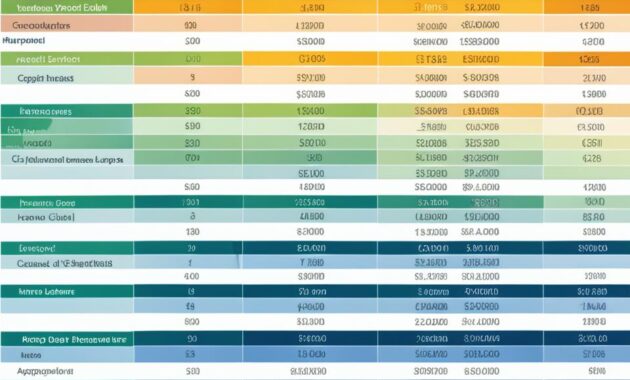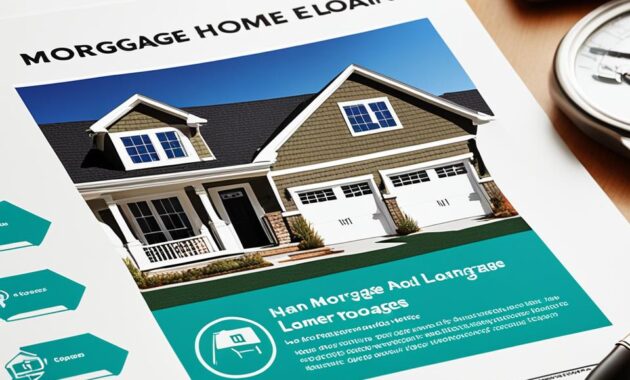Owning a home is a big dream and a smart investment1. With the right help, getting a home mortgage loan can lead you to homeownership. Learn the process, check your options, and work with experts to feel sure about your journey.
Buying a home has many steps, like checking if you’re ready and closing on your dream home1. Your credit score, income, savings for a down payment, and closing costs matter for getting a mortgage1. Look at your income, debts, and future costs to make a budget and find the right loan for you1.
Working with real estate pros can really help you out1. They can guide you to the perfect home and help with the mortgage application. Also, getting a home inspection before buying can make you feel secure and protect your money1.
Getting a home mortgage loan means filling out an application, giving documents, and going through underwriting1. This process can take 90 days or more, based on your situation and loan type2. But with patience and hard work, you can make it to homeownership and feel proud of your new home1.
Key Takeaways
- Homeownership is a big deal and a smart investment
- Check your finances, like credit score, income, and savings
- Get help from real estate pros for guidance and support
- Finish the mortgage application and give all needed documents
- Celebrate owning your home and enjoy its perks
Understanding Home Mortgage Loans
Buying a home is a big step in life. Most people need a home mortgage loan to do it. These loans let more people own homes by not needing to pay the full price upfront3. A home mortgage loan lets you buy a home by borrowing money from a lender like a bank or credit union. The loan is secured by the property, meaning if you don’t pay, the lender can take the home.
What is a Home Mortgage Loan?
A home mortgage loan is a long-term deal, lasting from 10 to 30 years3. You pay back the loan with monthly payments. These payments include part of the loan and the cost of borrowing the money. The interest rate can be fixed or adjustable, affecting how much you pay each month.
Types of Home Mortgage Loans
There are three main types of mortgage loans: conventional, FHA, and specialty loans3. Each has its own rules, benefits, and downsides.
- Conventional Loans: These loans come from private lenders and don’t have government backing. You can get a conventional loan with a down payment as low as 3%4. But, if your down payment is under 20%, you’ll need to pay private mortgage insurance (PMI), which is 0.2% – 2% of the loan4.
- Government-Backed Loans:
- FHA Loans: FHA loans are insured by the Federal Housing Administration and are easier to get if you have a low credit score. You pay an upfront insurance premium, and monthly premiums for 11 years if your down payment is 10% or more, or for the loan’s life if it’s less than 10%4.
- VA Loans: VA loans are for eligible military members, veterans, and their spouses. They have a funding fee that you can add to the loan4.
- USDA Loans: USDA loans are for buying homes in rural areas. They have upfront and monthly fees4.
| Loan Type | Minimum Credit Score | Minimum Down Payment | Mortgage Insurance |
|---|---|---|---|
| Conventional | 620 | 3% | PMI (if down payment |
| FHA | 500 | 3.5% | Upfront and monthly MIP |
| VA | 620 | 0% | Funding fee |
| USDA | 620 | 0% | Upfront and monthly guarantee fees |
When picking a home mortgage loan, look at offers from different lenders. Compare rates, fees, and service to get the best deal for your money.
Benefits of Homeownership
Starting on the journey of homeownership brings many benefits. It’s more than just having a place to live. One big plus is building equity over time. As you pay your mortgage, you gain equity in your home. This is a valuable asset for your future5. Rent money goes to your landlord and doesn’t help you grow your wealth5.
Homeownership also means stable housing costs. With a fixed-rate mortgage, your payments stay the same, no matter what5. This helps with long-term planning and budgeting. You know what your housing costs will be for years to come. Rent, on the other hand, can go up a lot each year5. Owning a home keeps you safe from rent increases and gives you a stable place to live.
Homeowners might get tax breaks too. You could get deductions for mortgage interest, property taxes, and more5. These can save you a lot on taxes, especially if you’re a first-time buyer5.
Owning a home is good for your health and well-being. Homeowners usually have more wealth than renters6. This wealth can make you feel more secure. Plus, many homeowners say they’re healthier than renters6.
Being a homeowner helps you feel part of a community. You can make lasting connections with neighbors5. Most homeowners stay in their homes for about 10 years, building strong social ties6.
“The ache for home lives in all of us, the safe place where we can go as we are and not be questioned.” – Maya Angelou
Getting to homeownership takes careful planning. But the long-term benefits are clear. You’ll build equity, have stable costs, and might get tax breaks. Plus, you’ll likely feel better physically and emotionally. Remember, the benefits of owning a home go way beyond your house. They help your financial security, personal growth, and sense of belonging.
Qualifying for a Home Mortgage Loan
Getting a home mortgage loan means lenders check several key things to see if you can get a loan. They look at your credit score, income, debt-to-income ratio, and how much money you have for a down payment and closing costs. Let’s dive into each of these and see how they affect your mortgage chances.
Credit Score Requirements
Your credit score is very important for getting a home mortgage loan. Scores go from 300 to 850, with higher scores showing a better credit history and less risk for lenders7. Most home loans need a minimum FICO Score of 6208. But, FHA loans might be possible with a score as low as 500 if you put down 10%, or 580 with a 3.5% down payment789. Veterans might get a VA Loan with a score of 5808, but the VA doesn’t set a minimum score7.
Higher credit scores mean more loan options and lower interest rates8. So, improving your credit score before applying for a mortgage is a good idea.
Income and Debt-to-Income Ratio
Lenders also look at your income and debt-to-income (DTI) ratio. Your DTI ratio is your monthly debt payments divided by your gross monthly income. It shows if you can handle the monthly mortgage payments7. Most lenders want your DTI to be less than 50% of your income8. But, the exact DTI needed can change based on the loan type, with conventional loans up to 45%, FHA loans up to 43%, and VA and USDA loans up to 41%9.
A stable income and a lower DTI ratio make you more appealing to lenders. It shows you can handle your debts and make your mortgage payments on time8.
Down Payment and Closing Costs
How much you have saved for a down payment and closing costs is key for getting a mortgage. Down payment amounts vary by loan type, from 0% for VA and USDA loans to 3% for conventional loans and 3.5% for FHA loans9. Some conventional loans might need private mortgage insurance (PMI) if your down payment is less than 20%8.
You’ll also need to plan for closing costs, which are usually 3% to 6% of the loan’s total value8. Saving more for a down payment can help reduce risk for lenders and might improve your loan approval chances8.
| Loan Type | Minimum Credit Score | Maximum DTI Ratio | Minimum Down Payment |
|---|---|---|---|
| Conventional | 620 | 45% | 3% |
| FHA | 580 (3.5% down) / 500 (10% down) | 43% | 3.5% |
| VA | No minimum (580 recommended) | 41% | 0% |
| USDA | No minimum (640 recommended) | 41% | 0% |
Getting a mortgage loan requires a detailed check of your credit, assets, and income7. Knowing these requirements and improving your finances can boost your chances of getting a mortgage and owning a home.
Choosing the Right Mortgage Lender
Starting your homeownership journey means picking the right mortgage lender. You have many options, so it’s key to compare them. This can save you a lot of money over the loan’s life10.

Look at the rates and fees when choosing a lender. Borrowers who compare offers from three lenders save a lot more than those who don’t10. Small differences in rates and fees can add up, changing the loan’s cost by several percentage points10. Always ask for loan estimates from several lenders to make a smart choice, saving you thousands11.
Comparing Mortgage Rates and Fees
When looking at mortgage rates, check the fine print. Lenders offer various mortgage types, each suited for different needs11. For example, conventional loans need only 3% down and are for those with good credit11. FHA loans are easier to get, and jumbo loans help with expensive homes10.
It’s smart to shop around for the best deal. A LendingTree study found that shopping saved borrowers an average of $63,15112. Remember, many mortgage inquiries in 45 days are counted as one on your credit report, so it won’t hurt your score much10.
Evaluating Customer Service and Reputation
Don’t forget about customer service and reputation when picking a lender. Choose lenders that are quick to respond and clear in their dealings. Reviews and recommendations from others can give you a good idea of a lender’s quality.
Think about using a mortgage broker to compare offers. NerdWallet reviews over 50 lenders, giving them a star rating based on many factors11. Their experts, with decades of experience, can help you make a good choice11.
By comparing lenders, you’ll find the best one for you. A bit of effort now can save you a lot later and make the process easier.
The Mortgage Application Process
Starting your journey to own a home means going through the mortgage application process. This is key to getting the loan you need for your dream home. Knowing what each step involves can make things easier and smoother for you.
Pre-approval and Home Shopping
Getting a mortgage pre-approval is smart before you start looking at houses. You share your financial details with a lender. They check if you can get a loan and how much you can borrow. Lenders give you a loan estimate within three days of your application, and it’s good for 10 days13.
With a pre-approval letter, you can look at homes knowing you’re in your budget. This shows sellers you’re a serious buyer.
Tip: Approach at least three different lenders for mortgage offers to compare rates and terms14.
Submitting Your Mortgage Application
After finding your perfect home and getting an offer accepted, it’s time to apply for a mortgage. You’ll need to give lots of details about your income, assets, debts, and the home you want to buy. Be ready to share things like pay stubs, tax returns, and bank statements. You’re also allowed one free credit report each year from the big three bureaus13.
You’ll also need to set up a home inspection and appraisal as part of the application. Inspections check the home’s condition, including its structure, plumbing, and more14. Appraisals make sure the home’s price is fair, helping you and the lender14.
Underwriting and Approval
After you apply, underwriters start checking your application. They’re key to making sure you get the mortgage13. They look at your credit, income, debts, and the home’s value. They check if you can afford the loan, your credit history, and the home’s worth14.
Getting your mortgage approved might mean meeting some extra requirements13. Once you meet those, you get final approval and your interest rate is set13. Remember, getting your mortgage closed can take about 45 days13.
Knowing the mortgage application process helps you feel confident on your path to homeownership. Being ready, open, and quick to respond can make getting your mortgage approved smoother and more likely.
Types of Home Mortgage Loans
Looking for the right home mortgage loan means knowing your options. There are two main types: conventional and government-backed loans. Each has its own benefits and features. Learning about these mortgages helps you pick the best one for your goals and dreams.

Conventional Home Mortgage Loans
Conventional loans are the most common type. They make up most of the mortgages in the U.S15.. These loans don’t come from the government. They usually need a higher credit score and down payment than other loans.
To get a conventional loan, you need a credit score of at least 62016. But, you can put down as little as 3% for a conforming, fixed-rate loan16.
Conventional loans are either conforming or non-conforming. Conforming loans follow Fannie Mae and Freddie Mac rules. Non-conforming loans, like jumbo loans, are bigger than these limits. Jumbo loans need a credit score of at least 70016.
“Conventional loans offer flexibility and competitive rates for borrowers with good credit and a stable income.” – Sarah Johnson, Mortgage Expert
Government-Backed Home Mortgage Loans (FHA, VA, USDA)
Government-backed loans, like FHA, VA, and USDA loans, help people who might not get conventional loans. They have easier credit score and down payment rules. This makes buying a home easier for more people.
- FHA Loans: FHA loans are for first-time buyers or those with lower credit scores. They have low down payments, helping those with scores as low as 5801516. But, FHA loans can’t be as big as some conventional loans16.
- VA Loans: VA loans are for veterans, active-duty members, and their spouses15. They don’t need a down payment, mortgage insurance, or a credit score16. But, they do have a fee at closing, from 1.25% to 3.3%16.
- USDA Loans: USDA loans are for those in rural areas with lower incomes. They offer good rates and terms15.
| Loan Type | Minimum Credit Score | Minimum Down Payment |
|---|---|---|
| Conventional | 620 | 3% |
| FHA | 580 | 3.5% |
| VA | No minimum | 0% |
| USDA | No minimum | 0% |
Choosing between a conventional and a government-backed loan depends on your finances and credit score. Think about the benefits each loan offers. Knowing your options helps you pick the best loan for your dream home.
Mortgage Refinancing Options
Homeowners often refinance their mortgages to get lower interest rates or to use their home’s equity. The most common type is a no cash-out refinance, which replaces the old mortgage with a new one without extra funds17. People refinance when the new rates are lower than when they first got their mortgage17.
Some homeowners switch from adjustable-rate to fixed-rate mortgages for stable payments17. Others refinance to a shorter loan term, like from a 30-year to a 15-year mortgage. This can help them pay off their mortgage faster and save on interest1718.
Cash-out refinancing lets homeowners get cash for home improvements or financial needs by taking out a bigger mortgage1719. But, these mortgages usually have higher rates because you’re borrowing more17.
When thinking about refinancing, it’s smart to talk to several lenders to compare costs17. Remember, you’ll pay all the costs of the new loan after refinancing17. Closing costs for refinancing can be 3% to 6% of the loan’s total19.
| Refinancing Option | Description |
|---|---|
| Cash-out Refinance | Take out a new mortgage that exceeds the original loan amount to access funds |
| Cash-in Refinance | Put a significant sum of money into the refinancing process to lower the loan-to-value ratio and potentially reduce monthly payments |
| FHA Streamline Refinance | Lower monthly payments and avoid FHA appraisal processes for holders of FHA loans |
| VA Streamline Refinance (VA IRRRL) | Potential interest rate reduction and loan term adjustments for military veterans and active service members with VA loans |
| USDA Streamline Refinance | Interest rate reduction and potential changes to loan terms for USDA loan holders with minimal equity, without requiring appraisals or inspections |
| Reverse Mortgage | Access funds from home equity without making immediate loan payments, available to borrowers aged 62 and above with sufficient equity |
| No-closing-cost Refinance | Cover closing costs with a higher interest rate or by rolling them into the loan balance, ideal for short-term homeowners or those with immediate financial needs |
| Short Refinance | Options for borrowers facing foreclosure, where the lender adjusts the existing mortgage to lower monthly payments and potentially avoid foreclosure proceedings |
There are nine types of mortgage refinancing options19. Homeowners can find the best solution for their financial needs. By looking at their choices and working with trusted lenders, they can refinance to lower rates, change loan terms, or use their home’s equity wisely.
First-Time Homebuyer Programs
Buying your first home is exciting but can be hard, especially with financing. Luckily, there are many programs for first-time buyers. These programs help make buying a home easier and cheaper.
First-time homebuyer programs make it easier with lower down payments. Conventional loans usually need a 3% down payment20. But, FHA loans can be as low as 3.5%21. VA and USDA loans might not need any down payment at all21.
These programs also offer help with down payments. You can get low-interest loans or grants to cover costs20. Some even match your savings for down payments and closing costs20.
Georgia Dream Homeownership Program
The Georgia Dream Homeownership Program helps first-time buyers in Georgia. It offers low mortgage rates, down payment help, and education.
To get into this program, you need to meet certain income and credit standards. It also helps active military, teachers, and others, making it easier for them to buy homes.
Down Payment Assistance Programs
Down payment assistance is key for many first-time buyer programs. It helps cover the down payment gap, making buying a home possible for those with little savings.
Some programs focus on specific groups, like first-time buyers or certain professions. They offer loans up to $35,00020. Others give big discounts to certain workers in certain areas20.
Groups like NACA and Habitat for Humanity also help with low-rate mortgages for low-income buyers20. They aim to make affordable housing and support first-time buyers.
With the right programs and support, first-time buyers can make their dream of owning a home come true. They can confidently go through the buying process and start building wealth through homeownership.
Tips for Successful Homeownership
Getting ready for homeownership means planning and budgeting well. With home prices high and inventory low in the U.S., being ready for expenses is key. Plan to spend 1% to 3% of your home’s value yearly on upkeep, like mortgage, taxes, insurance, and repairs22. A budget for these costs keeps you on track and avoids stress.
Having an emergency fund is also vital for unexpected repairs or financial issues. Try to save three to six months of expenses in a savings account. Keeping up with home maintenance is crucial. Do tasks like cleaning gutters and fixing small repairs quickly to avoid big costs later.
It’s important to talk with your mortgage lender often. Remember, preapprovals for mortgages last only 90 days22. If you’re buying your first home, use programs like down payment help22. These can make buying a home easier. By following these tips and keeping up with your mortgage, you’ll enjoy the perks of owning your home.
Source Links
- https://trainual.com/manual/your-path-to-homeownership-how-to-buy-a-house-and-make-your-dream-home-a-reality
- https://www.rocketmortgage.com/learn/mortgage-loan-process
- https://www.investopedia.com/terms/h/home-mortgage.asp
- https://www.rocketmortgage.com/learn/what-is-a-mortgage
- https://www.atlanticbay.com/knowledge-center/top-5-advantages-of-homeownership/
- https://www.lendingtree.com/home/mortgage/benefits-of-owning-home/
- https://www.gtfcu.org/articles/the-basics-of-qualifying-for-a-mortgage-loan
- https://www.rocketmortgage.com/learn/mortgage-qualification
- https://www.lendingtree.com/home/mortgage/minimum-mortgage-requirements/
- https://www.bankrate.com/mortgages/finding-the-best-mortgage-lender/
- https://www.nerdwallet.com/best/mortgages/tips-for-finding-best-mortgage-lender
- https://www.lendingtree.com/home/mortgage/how-to-choose-a-mortgage-lender/
- https://www.investopedia.com/mortgage-process-explained-5213694
- https://themortgagereports.com/65881/mortgage-loan-process-explained-in-9-steps
- https://www.consumerfinance.gov/owning-a-home/explore/understand-the-different-kinds-of-loans-available/
- https://www.bankrate.com/mortgages/types-of-mortgages/
- https://myhome.freddiemac.com/refinancing/options-for-refinancing
- https://www.bankofamerica.com/mortgage/refinance/
- https://www.rocketmortgage.com/learn/types-of-refinance
- https://www.bankrate.com/mortgages/first-time-homebuyer-loans-and-programs/
- https://www.nerdwallet.com/article/mortgages/programs-help-first-time-homebuyers
- https://www.bankrate.com/mortgages/tips-for-first-time-home-buyers/







